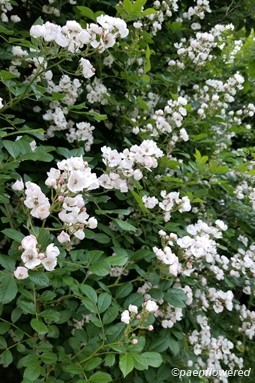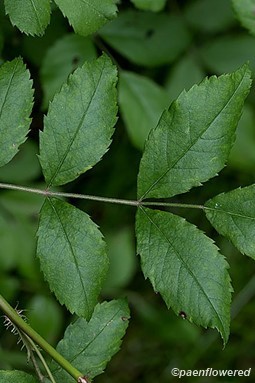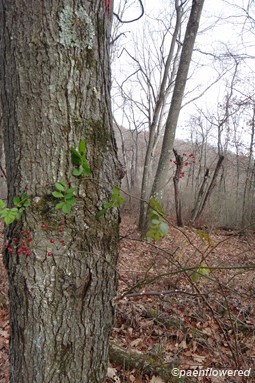Rosa multiflora
An invasive prickly white-flowered bush
Rosa multiflora multiflora rose
Sometimes a very pretty flowering plant can have a dark side. That is the case with this species. There are 24 species of wild roses in the northeastern United States. Most of them are pink. The multi-floral rose is one of two white species. The white flowers of this species bloom in May and June. In addition to its color, it can be recognized its cluster of small blossoms and toothed stipules (modified leaves lying close to the stem where it branches). The flowers are sometimes mistaken for blackberry bramble but the flowers of this species usually have a slight notch at the end. It also has pinnately compound leaves with 7-9 leaflets while the blackberry bramble has 3-part leaves.
The ¼ inch red fruit (hips) appears in August and persist into the winter. These hips require some time to dry out, split open and release its many seeds. Individual plants may produce up to 50,000 seeds a season. These can remain viable in the soil for up to 20 years.
This is not a native species, but a widespread garden escapee that had been imported from Asia as a hedge shrub and soil conservation plant. Its planting was encouraged by the USDA and many states into the 1960s. In many places it has now become an invasive pest, forming dense impenetrable thorny masses that force out native plants. It is officially classed as a noxious weed in Pennsylvania.
This species does well in full or partial sunlight and so often grows close to roadsides and along streams from New England south. The bush can grow up to 15 feet high. The fragrant flowers have the typical five petals of a wild rose. . There are numerous stamens and pistils. The stamens seem to vary in color from orange to brown as the flower matures. The stems often have flattened prickles that are curved backwards.
This species blooms from mid-May until June. It is normally difficult to eliminate physically without pulling up all of the roots. Currently, however, the rose rosette virus, carried by mites, is attacking the multi-flowered rose and has reached Western Pennsylvania. From the abundant growth evident here, the virus seems to be having limited effect so far. Some fear, though, that spaces left by the death of the rose will be filled by honeysuckle or other invasive species.
A minor positive factor about this plant is that it does provide cover and food for wildlife.
Habitat & Range
Naturalized in disturbed woods, pastures, old fields, roadsides, and thickets.
Present throughout the state.
| EMP: | FACU |
|---|---|
| NCNE: | FACU |
Phenology
Flowers late May to June.











Comments
Have you spotted this plant in your area? We'd love to hear about your experience! Share your comments or questions about the plant below. Comments are moderated before posting.